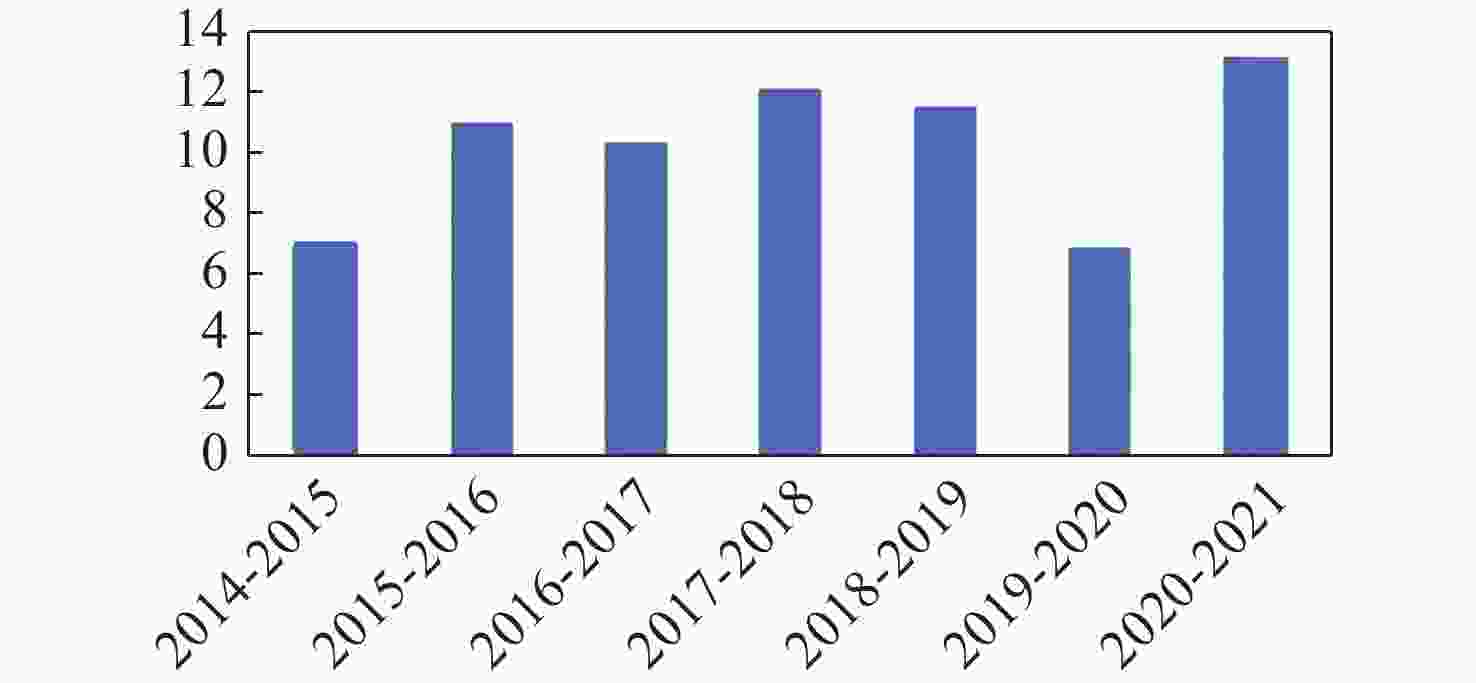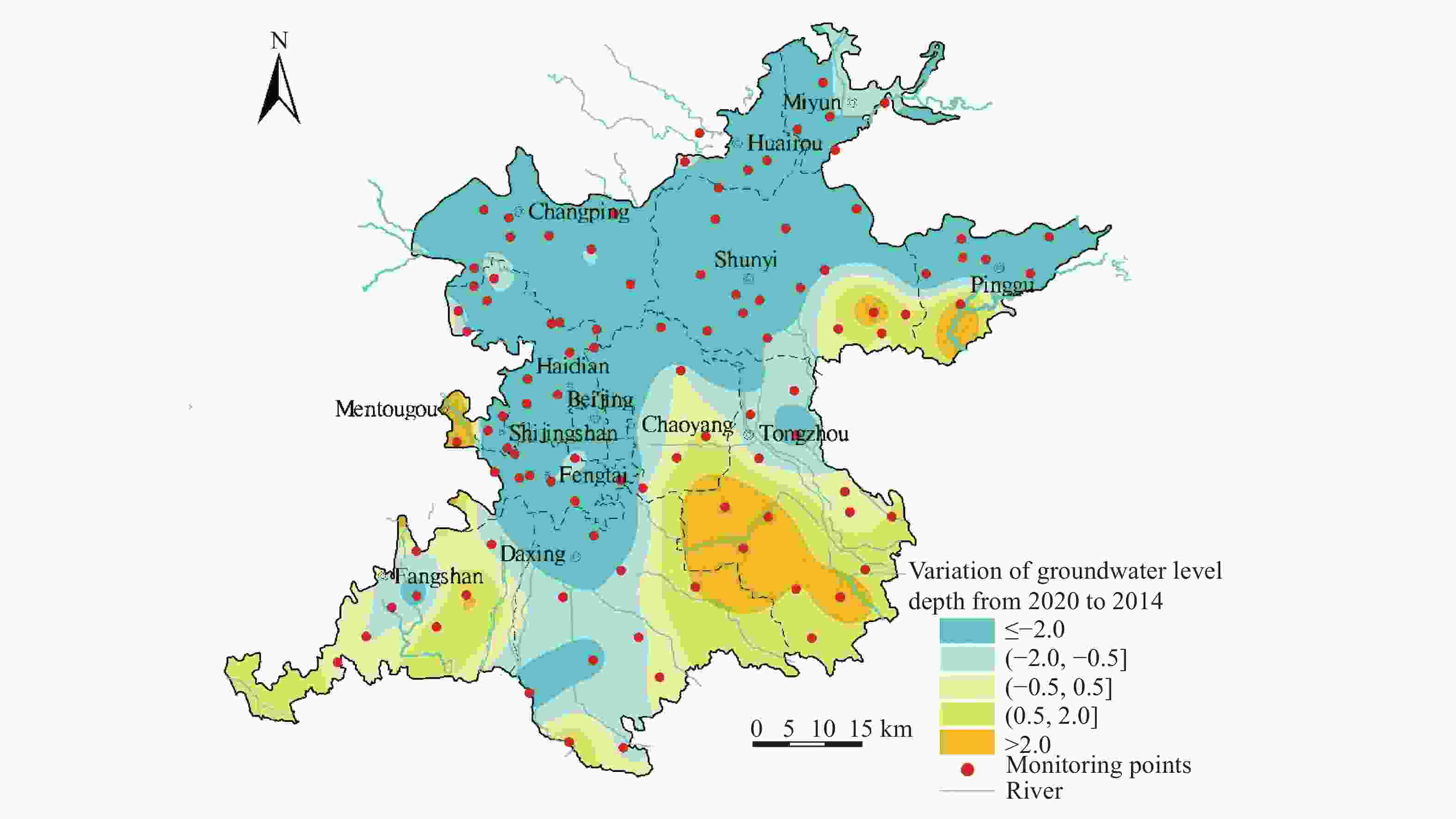Effectiveness of groundwater extraction in Beijing since the ingauration of the first phase of the South-to-North Water Diversion Project, China
-
Abstract: This study assess the effectiveness of groundwater pressure extraction in Beijing since the opening of the first phase of the South-to-North Water Diversion Project, using survey and evaluation methods. Firstly, an analysis of water consumption structure and the usage of diverted river water in Beijing in recent years was conducted. Secondly, the volume of groundwater pressure extraction in Beijing after the project's inauguration was examined, revealing a decrease from 1.96 billion m3 in 2014 to 1.35 billion m3 in 2020. The proportion of water supply reduced from 52.3% in 2014 to 33.3% in 2020, leading to an optimized water supply structure. By the end of 2020, groundwater pressure extraction in Beijing is estimated at 446 million m3, with a substantial reduction in over-exploitation of groundwater. Groundwater resources have been effectively replenished, and the strategic reserve capacity has been enhanced. Furthermore, this study evaluates the change in groundwater levels as an indicator of the effectiveness of pressure extraction. The declining trend of groundwater levels in Beijing has been effectively mitigated, and there has been a consistent rebound in groundwater levels over the past five years.
-
Table 1. Changes in groundwater levels in 114 monitoring wells in the Beijing plain area
Number of water level change monitoring points Annual end-of-December water level 2015 minus 2014 2016 minus 2015 2017 minus 2016 2018 minus 2017 2019 minus 2018 2020 minus 2019 2020 minus 2014 Rising water level 31 50 38 42 45 47 79 Water level stabilization 40 47 49 53 29 42 17 Water level drop 43 17 27 19 40 25 18 Average water level/m Decrease of 0.12 Increase of 0.52 Increase of 0.26 Increase of 1.94 Increase of 0.32 Increase of 0.68 Increase of 3.72 Table 2. Statistics on the proportion of shallow groundwater with different depth intervals in Beijing from 2014 to 2020 / %
Timing Depth of burial
≤10 mDepth of burial
10–20 mDepth of burial
20–30 mDepth of burial
30–40 mDepth of burial
40–50 mDepth of burial
> 50 mDecember 2014 13.62 27.73 21.42 32.00 4.39 0.85 December 2015 13.17 28.51 20.86 31.80 4.69 0.97 December 2016 14.66 28.45 22.08 29.22 4.62 0.98 December 2017 14.06 29.94 24.58 26.62 4.04 0.76 December 2018 14.07 30.80 32.40 20.35 2.21 0.17 December 2019 11.80 34.59 35.82 15.50 2.00 0.29 December 2020 12.58 36.30 35.65 13.95 1.43 0.08 -
Adams M, Smith PL, Yang XH. 2015. Assessing the effects of groundwater extraction on coastal groundwater-dependent ecosystems using satellite imagery. Marine and Freshwater Research, 66(3): 226. DOI: 10.1071/mf14010. Cao WG, Wen AX, Nan T, et al. 2023. Evaluation of the suitability of groundwater recharge in typical areas of the Haihe River Basin. Advances in Water Science, 34(2): 227−237. (in Chinese) DOI: 10.14042/j.cnki.32.1309.2023.02.007. Cao WG, Zhang Z, Guo HM, et al. 2023. Spatial distribution and controlling mechanisms of high fluoride groundwater in the coastal plain of Bohai Rim, North China. Journal of Hydrology, 617: 128952. DOI: 10.1016/j.jhydrol.2022.128952. Cao WG, Yang HF, Gao YY, et al. 2020. Prediction of groundwater quality evolution in the Baoding Plain of the SNWDP benefited regions. Journal of Hydraulic Engineering, 51(8): 924−935. (in Chinese) DOI: 10.13243/j.cnki.slxb.20200035. Cao YB, Wei YN, Fan W, et al. 2020. Experimental study of land subsidence in response to groundwater withdrawal and recharge in Changping District of Beijing. PLoS One, 15(5): e0232828. DOI: 10.1371/journal.pone.0232828. Chen F, Ding YY, Li YY, et al. 2020. Practice and consideration of groundwater overexploitation in North China Plain. South-to-North Water Transfers and Water Science & Technology, 18(2): 191−198. (in Chinese) DOI: 10.13476/j.cnki.nsbdqk.2020.0042. Chen XJ, Wang LF, Jia LQ, et al. 2021. China's water resources in 2020. China Geology, 4: 536−538. DOI: 10.31035/cg2021063. Du ZY, Ge LL, Ng AHM, et al. 2021. Analysis of the impact of the South-to-North water diversion project on water balance and land subsidence in Beijing, China between 2007 and 2020. Journal of Hydrology, 603: 126990. DOI: 10.1016/j.jhydrol.2021.126990. Ge YX, Wu J, Li BH, et al. 2022. Analysis and evaluation of variation characteristics in groundwater resources carrying capacity in Beijing between 2010 and 2020. Sustainability, 14(15): 9200. DOI: 10.3390/su14159200. Guo L, Gong HL, Ke YH, et al. 2021. Mechanism of land subsidence mutation in Beijing plain under the background of urban expansion. Remote Sensing, 13(16): 3086. DOI: 10.3390/rs13163086. Hao QC, Shao JL, Xie ZH, et al. 2012. A Study of the artificial adjustment of groundwater storage of the Yongding River alluvial fan in Beijing. Hydrogeology & Engineering Geology, 39(4): 12−18. (in Chinese) DOI: 10.16030/j.cnki.issn.1000-3665.2012.04.016. Hout EVD, Doelder BD. 2015. Urban groundwater management as risk reduction tool for groundwater extractions. Ebook. IOS Press: Geotechnical Safety and Risk V: 139-143. Hu Q. 2017. Utilization and prevention of groundwater resources in Beijing-Tianjin-Hebei region. Chinese & Foreign Entrepreneurs, (18): 51,57. (in Chinese) Li C, Men BH, Yin SY. 2022. Analysis of groundwater chemical characteristics and spatiotemporal evolution trends of influencing factors in southern Beijing plain. Frontiers in Environmental Science, 10: 913542. DOI: 10.3389/fenvs.2022.913542. Liao ZM, Zang N, Wang X, et al. 2021. Machine learning-based prediction of chlorophyll-a variations in receiving reservoir of world's largest water transfer project—a case study in the Miyun Reservoir, North China. Water, 13(17): 2406. DOI: 10.3390/w13172406. Liu XL. 2020. Role of Middle Route Scheme of South to North Water Diversion to control overexploitation of groundwater in North China. China Water Resources, (13): 31−32. (in Chinese) DOI: 10.3969/j.issn.1000-1123.2020.13.018. Liu YY, Zheng H, Wan WH, et al. 2023. Optimal operation toward energy efficiency of the long-distance water transfer project. Journal of Hydrology, 618: 129152. DOI: 10.1016/j.jhydrol.2023.129152. Luo Y, Chen BB, Lei KC, et al. 2019. Optimum design of level monitoring points for land subsidence. Bulletin of Engineering Geology and the Environment, 78(7): 5135−5146. DOI: 10.1007/s10064-018-01442-6. Pang YJ, Zhang H, Cheng HH, et al. 2020. The modulation of groundwater exploitation on crustal stress in the North China Plain, and its implications on seismicity. Journal of Asian Earth Sciences, 189: 104141. DOI: 10.1016/j.jseaes.2019.104141. Qin HH, Zheng CM, He X, et al. 2019. Analysis of water management scenarios using coupled hydrological and system dynamics modeling. Water Resources Management, 33(14): 4849−4863. DOI: 10.1007/s11269-019-02410-9. Qin HH. 2021. Numerical groundwater modeling and scenario analysis of Beijing plain: Implications for sustainable groundwater management in a region with intense groundwater depletion. Environmental Earth Sciences, 80(15): 499. DOI: 10.1007/s12665-021-09795-0. Si Y, Chen BB, Gong HL, et al. 2018. Temporal and spatial evolution of land subsidence induced by groundwater exploitation and construction in the eastern Chaoyang district, Beijing, China. Journal of the Indian Society of Remote Sensing, 46(10): 1657−1665. DOI: 10.1007/s12524-018-0821-z. Su QM, Chang HS, Chen X, et al. 2022. Metacoupling of water transfer: The interaction of ecological environment in the middle route of China’s south-north project. International Journal of Environmental Research and Public Health, 19(17): 10555. DOI: 10.3390/ijerph191710555. Sun L, Zhang YB, Si HY, et al. 2021. Simulation and prediction of shallow groundwater depth in the North China Plain based on regional periodic characteristics. Environmental Earth Sciences, 80(18): 635. DOI: 10.1007/s12665-021-09933-8. Wang LH, Jia BH, Xie ZH, et al. 2022. Impact of groundwater extraction on hydrological process over the Beijing-Tianjin-Hebei region, China. Journal of Hydrology, 609: 127689. DOI: 10.1016/j.jhydrol.2022.127689. Wang SF, Li J, Liu YZ, et al. 2019. Impact of South-to-North Water Diversion on groundwater recovery in Beijing. China Water Resources, (7): 26−30. (in Chinese) DOI: 10.3969/j.issn.1000-1123.2019.07.008. Xu BT, Yang YL, Geng JK, et al. 2020. Analysis on countermeasures about treatment of groundwater over-abstraction in Hebei Province. Haihe Water Resources, (6): 6−8. (in Chinese) DOI: 10.3969/j.issn.1004-7328.2020.06.003. Yang L, Zhu QL, Sun J, et al. 2017. Water supply benefit evaluation of Middle Route Project of South-to-North Water Diversion in Beijing City. Yangtze River, 48(10): 44−46,78. (in Chinese) DOI: 10.16232/j.cnki.1001-4179.2017.10.010. Yang ZW, Liu HL, Yang TT, et al. 2015. A path-based structural decomposition analysis of Beijing's water footprint evolution. Environmental Earth Sciences, 74(3): 2729−2742. DOI: 10.1007/s12665-015-4484-6. Zhang XY, Chen JF, Yu C, et al. 2023. Emergency risk assessment of sudden water pollution in South-to-North Water Diversion Project in China based on driving force–pressure–state–impact–response (DPSIR) model and variable fuzzy set. Environment, Development and Sustainability. Zhao K, Qi JX, Chen Y, et al. 2021. Hydrogeochemical characteristics of groundwater and pore-water and the paleoenvironmental evolution in the past 3.10 Ma in the Xiong'an New Area, North China. China Geology, 4: 476−486. DOI: 10.31035/cg2021058. Zhao Y, Wang LZ, Li HH, et al. 2020. Evaluation of groundwater overdraft governance measures in Hengshui city, China. Sustainability, 12(9): 3564. DOI: 10.3390/su12093564. Zheng YZ, Peng JH, Chen X, et al. 2022. Spatial and temporal evolution of ground subsidence in the Beijing plain area using long time series interferometry. IEEE Journal of Selected Topics in Applied Earth Observations and Remote Sensing, 16: 153−165. DOI: 10.1109/JSTARS.2022.3223027. Zhou H, Dai M, Wei M, et al. 2023. Quantitative assessment of shallow groundwater sustainability in North China plain. Remote Sensing, 15(2): 474. DOI: 10.3390/rs15020474. -

 E-mail alert
E-mail alert Rss
Rss



 下载:
下载:






















